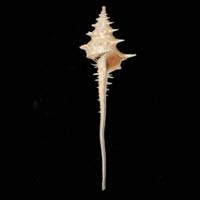|
< Previous family introduction |
|
|||||
|
|
Family Turbinellidae Pagoda and Vase Shells
The family Turbinellidae consists of five subfamilies, until recently regarded as separate families, but now aggregated because of common features in the anatomy. The family is best known for the large, tropical, heavy-shelled species in the subfamilies Turbinellinae and Vasinae. The subfamilies Columbariinae and Ptychatractinae occur in the bathyal zone and are more diverse and widely distributed, occurring from equatorial to polar latitudes. The subfamily Tudiclinae has only one living representative but an extensive fossil history. The externally visible uniting features of the subfamilies are bulbous protoconchs, open, elongate siphonal canals, and corneous opercula with a terminal nucleus. Their diet is sipunculids (peanut worms) and polychaete worms (Harasewych, 1987). The family is only sparsely represented in NSW with one species of Vasinae, three of Columbariinae but none of the other subfamilies. In the subfamily Columbariinae there is about 50 species, but 40 of these are known only as fossils. The living species are found in the Indo-Pacific and West Atlantic, occurring in deep water from about 70 to 800 metres. The three species which occur in NSW are now reasonably commonly taken by trawlers working in deep water, but until commercial fishing began on the continental slope these species were regarded as extremely rare. Columbarium pagodoides was described from two specimens in 1882, and no further specimens had become available when the family was reviewed in 1969 (Darragh, 1969). Family References
Identification Notes The shape and sculpture of the peripheral keel is an important feature in separating species in the Columbariinae, but it must be used with care. In good specimens keel sculpture is distinct, but it is variable in some species and often worn away or broken. Coverage All species of the family known from NSW are described here.
|
